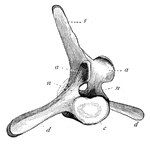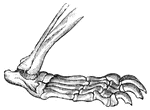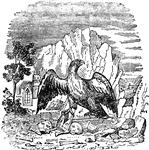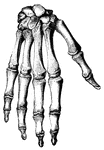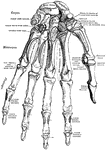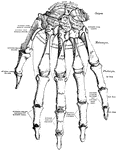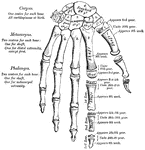
Six-banded armadillo
Armadillos live on carrion, insects and fruit. They are all small, except for the Gigantic armadillo…
Bones of Arm
Arm of humans; h Humerus or bone of upper arm; r and u Radius and Ulna, or bones of the forearm; c Carpus,…

bones of arm
Wing of Bird; h Humerus or bone of upper arm; r and u Radius and Ulna, or bones of the forearm; c Carpus,…
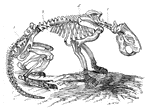
Beaver Skeleton
The skeleton of a beaver.(c) cervical region of vertebral column; (d) dorsal region; (b) lumbar region;…

Chimp Limb
The forelimb of chimpanzee. (c) collar bone; (s) shoulder blade; (h) humerus; (r) radius; (u) ulna;…
Chimp Limb
The hindlimb of chimpanzee. (i) innominate bone; (f) thigh bone; (t) tibia; (s) fibula; (r) bones of…

Fish Skeleton
Skeleton of the common Perch. (p) one of the pectoral fins; (v) one of the ventral fins; (a) anal fin,…

Manassasas Junction
"Manassasas Junction, showing the evacuated Confederate fortifications, abondoned camps and wagons,…

Fort Hindman
"The investment of Fort Hindman, Arkansas Post, Ark., by the Federal troops under General McClernand,…

War in Virginia
"The war in Virginia- officers and men of Meade's army discovering unburied Federal dead on the old…
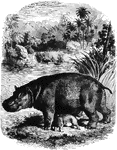
Hippopotamus
"Of this the muzzle is exceedingly thick and blunt, the head is very large, but the greater part of…
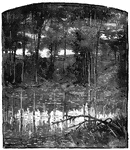
Bloody Pond
"Bloody Pond, near Lake George, which is said to still contain the bones of many of those who fell in…

Perch skeleton
"The bones of fishes are of a less dense and compact nature than in the higher order of animals; in…
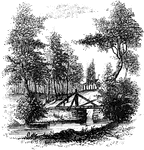
Sleepy Hollow
"Bridge over Sleepy Hollow Creek. Ichabod, according to Irving, in the Legend, returning from…
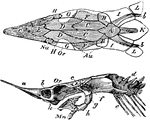
Sturgeon Skull
"Top and side views. The cartilaginous cranium shaded, is supposed to be seen through the unshded canial…

Buffalo
"The Buffalo. As the game upon which they depended moved about the country, so the Indians roved in…

Side View of Bones in Foot
"The Foot is that part of the lower extremity below the leg on which we stand and walk. It is composed…

Side View of Bones in Foot
"The Foot is that part of the lower extremity below the leg on which we stand and walk. It is composed…
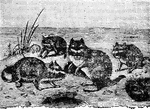
Viscacha
"Viscacha is a stout-built rodent, resembling a marmot, from 18 inches to two feet long, exclusive of…

Human skeleton
"There are in all two hundred and six seperate bones in the adult skelton. The teeth are not bones,…
Spinal column
"The spine or backbone, serves as a support for the whole body. It is made up of a number of…
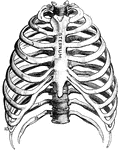
Thorax
"The ribs are long, flat, and curved bones which bend round the chest somewhat like the hoops…
Humerus
"The humerus, a long, hollow bone, rests against a shallow socket on the shoulder blade. It…
Ulna and Radius
"The ulna, or elbow bone, is the larger of these two bones. It is joined to the humerus by…
Tibia and Fibula
"The leg consists, like the forearm, of two bones. The larger, a strong, three-sided bone with…
Bones of the Foot
"The foot is built in the form of a half-dome or half-arch. This is to afford a broad, strong support…

Elbow Joint
"Showing how the Ends of the Bones are shaped to form the Elbow Joint. The cut ends of a few ligaments…

Powerful Ligament at the Hip Joint
"The bones are fastened together, kept in place, and their movements limited, by tough and strong bands,…

Ligaments of the Foot and Ankle
"The bones are fastened together, kept in place, and their movements limited, by tough and strong bands,…
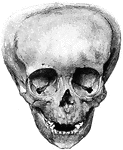
Deformed skull
"Showing how the Bones of the Skull may be artificially deformed by "head-binding." From the photograph…

Achillles tendon
"Tendons are white, glistening cords, or straps, which connect the muscles with the bones." —…
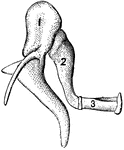
Bones of the Ear
"1, malleus, or hammer; 2, incus, or anvil; 3, stapes, or stirrup." — Blaisedell, 1904

Skeleton of the Mammoth
"Mammoth is a species of extinct elephant, the fossil remains of which are found in European, Asiatic…

Swordfish
"Swordfish is a popular name for any individual of the Xiphiidæ. They are pelagic fishes, widely…
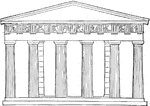
Thesium restored
"The Theseum is situated on a height to the north of the Areopagus, and was built to receive the bones…
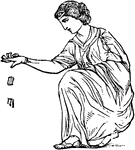
Talus
"Talus. The huckle-bones of sheep and goats were used to play with from the earliest times, principally…
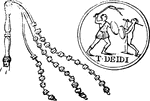
Scourge
"The Furies are generally represented with a scourge, with which to punish the wicked in Tartarus. It…
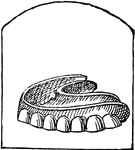
Teeth
The series of small bones attached to the jaws of animals, or human beings, which serve the purpose…

Human skeleton
"The human body, like a great building, has a framework which gives the body its shape and provides…
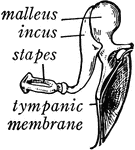
Bones of the Ear
"Across the middle ear a chain of three small bones stretches from the tympanic membrane to the inner…

Veins and arteries
"Chief veins and arteries of the body. a, place of the heart; the veins are in black. On the right side…
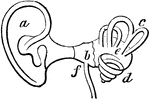
Ear
Interior of the ear. There is external to the head a wide-mouthed tube, or ear-trumpet (a), for catching…

Side View of the Body
A side view of the two great cavities of the body and their organs. 1: The mouth. 2: The thorax. 3:…
Spinal Column
The spinal column. 1, 2, and 3: Vertebrae. 4 and 5: The sacrum and cocyx bones of the pelvis. 6: Processes.

Swordfish
A family of spinyrayed fished allied to the mackerels. They attain a length of fifteen feet, and have…

Forearm Bones
This diagram shows the bones of the right fore-arm. H, the humerus; R, the radius; and U, the ulna.
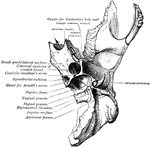
Temporal Bone
Bones situated at the sides and base of the skull. Each consists of five parts: the squama, the petrous,…
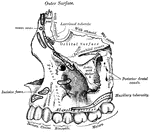
Maxilla
The largest bones of the face, excepting the mandible, and form, by their union, the whole of the upper…
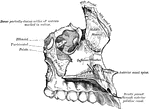
Maxilla
The largest bones of the face, excepting the mandible, and form, by their union, the whole of the upper…
